Two decades focus on "Communities" Howard Rheingold. 1.* - unedited transcript -
I went and spoke with CEO┬'s and watched them come up and operate the mouse. Many of them said well how do you work this thing. They will die and that will go away. This is a slide that is my web site. I┬'m not sure where the intersection is between what I do and what Doug does is. One way I was thinking about that when I was watching Doug explain things. Doug is doing this from the top of his head. I am going to talk about the things that I have been doing by the seat of my pants for quite a while. I stumbled into it. I met Doug because when the personal computers came out, I was convinced that there was a way to write with them not knowing that there were some people who were using these things called text editors. Via Xerox Park, I found out about these things and about Doug and that led me to write tools for thought. I remember the day I was driving on the 101 and feeling like my life was going in a new direction because I had met this person. There are probably others of you out there that have had this kind of experience. It was not the kind of thing that was prescribed. I started thinking about things and got a personal computer and word processors came along. I heard about the stuff that was going on with ARPnet but wasn┬'t qualified to participate in. So I discovered the bulletin board systems around. There was something called The Source, about 1982-83, when I first started messing with this stuff. Then there was The Well, which was less expensive. The cyberspace is really a social place. I started looking for information, but really found people. Stayed there for quite a while. I wrote another book called The Virtual Community about all that. With both the books: Closer Thought, which I talked about Doug, and The Virtual Community, I revisited and re-interviewed people and have updated them and they are coming out by MIT Press. It was not long before I spent many hours staying on-line. Like many people who got drawn into this business of communicating with people on-line, I had some conflict with my wife. She felt it was strange that I was communicating with these invisible people. I would be laughing or crying and found myself alone in the room. In the book I tell the story of one night when my wife found a tic on my infant daughter┬'s head and it┬'s not really a big medical emergency. But it was our first baby and there┬'s this gross floating insect sucking your baby┬'s brain, you want to communicate this with someone. My wife called the p and I logged on to the web. I got a look from my wife. I went into the parenting conference and found a discussing about medical problems. I posted a quarry and fortunately got an e-mail reply from someone who I knew to be a legitimate medical authority. I had removed the tic by the time the physician called my wife back. That is the beginning. Our infant daughter is now a teenager, and she does instant chat, Internet conference calls, and chat, and then claims that she is doing her homework. She gets good grades, she is doing her homework. A number of different experiences, many of them voluntary, some of them commercial enterprises, done for myself or others, I probably started 15 other virtual communities. To some extent, what I am involved in now are consciously improvement communities. With our ability to collectively be knowledge resources, as a writer, this has been an incredibly valued resource.
It has been part of my life just to put a question out there and get an answer back from someone who I have never heard of or met before. There are issues about the quality of that information. We were doing this for a good decade before the web came along, and search engines came along. And combine that information with the ability to sift through the information that is out there with the capability of a group to do a collective knowledge gathering. A gift economy of providing questions and answers. I don┬'t think it would be possible for me to do the things that I have without having that. A lot that I tried to write about it is not something that I have formulated and abstracted as Doug has. It has been things that I discovered by the seat of my pants. More consciously I am involved in trying to raise the bar of the kind of discourse that can happen in a many to many, synchronous, asynchronous, multi-media kind of community atmosphere. The kinds of communities that Doug is talking about that are designed can be informed from what we learn from these informal communities. That are only grown and partially designed. In order to grow them you have to know them and be inside and know what is required. Some of what is required is somewhat onerous. As all attempts to deal with diverse humans who communicate with each other regularly. People have conflicts, the fact that you are disembodies. No one can punch you in the nose for what you say. It does create the possibility for a lot of misunderstandings. As you get more and more involved with this type of communications, the lack of cues goes away. But as long as you are not in the same room with people means there are going to be a lot of exacerbated social problems. How a group deals with those problems is a book right there. Aside from what our intellectual goals are for participating in a distributed community, we are social beings and we are going to have to deal with these personality conflicts. Doing it governs framework that is more or less fair. Or the people will go away. The media itself is evolving rapidly. Before it is words on a screen in user net style BBS or and irisy or chat room synchronous activity.
Now we are seeing increasingly millions of people having access to what Doug cooked up decades ago. The video, the synchronous, the asynchronous, the search capabilities, and the voice, all in the same environment. We have had the telephone for close to 100 years and still, people abuse it daily. Our social literacy about communication technology lags the capabilities of the technology that┬'s not gone away. Maybe it┬'s because people are aware that it is an invisible cloud of social norms that surrounds any technology that involves humans communicating. That we are more able to raise the awareness of those norms. This paramedic story on Internet is the use net and the September net that never ended. It used to be that every September a lot of freshmen would get access to the Internet and use net. They wouldn┬'t read the facts and they wouldn┬'t understand the etiquette. The people that participated in that community too the time to teach them the norms because the more people on hand that understand those norms, the more valuable the community is to everyone. It┬'s a collective good and commons. When people understand how they can contribute to it, rather than just take out it becomes increasingly valuable. AOL dumped several million people to use net, with out any instruction or etiquette. That became known as the September that never ended. In that community, it may be that what kept Usenet signal the noise ratio totally manageable and a community for decades, broke down. People were overwhelmed by the people who were coming aboard. Norm┬'s people voluntarily teach each other, rules are something that you assign. It is more difficult to garden norms than design rules. The people on line in this communication environment are new to it. The problem of addressing the norms is a big one. Are we going to be able to evolve our way to make it useful of hundreds of millions of people as it was for tens of thousands? Every virtual community has social contract. You set out the rules at the beginning, or they emerge from people dealing with transgressions.
On-line communities cannot exist without people cooperating and contributing. Some of them go on for a long time because some people have a need for conflict and enjoy it. It is fine for those places to exist. There is no need to make a moral judgment. But there are other places that need to have more cooperation then we find otherwise. How can we create such a social contract through a group? It┬'s easier to formulate it first, and have people agree with it. Rather than try to get a group who┬'s only connection is on-line, then try and get them to come up with something. People adopt roles, as coaches, hosts, and cybrarians. Coaches are the people that are going to sit down with you, get on the phone, or e-mail, and help you figure out how to use things. On-line tools or norms. Hosts are like a party. Those facilities need to meet people, remove fights into the hall, and keep conversations going. They naturally evolve or you can train people to do it. Cyberian is someone whose job are knowledge management, and also someone who lives in the community. Idle talk is social glue. If it is not fun people will not contribute. You cannot step on fun if people start having it. People who make friends in those informal settings are more likely to have useful knowledge in a more formal setting. Also learning is a social activity. When people are not compelled to participate, they do it voluntarily. Inventing things and sharing knowledge is fun.
People become more serious with what they have done with Usenet groups for many years and they have more intentional communities of short or long duration of people who┬'s only connection is an affinity or practice where that type of application of ability and knowledge connection is desirable. How you do that in an informal role and connect it to the world Doug is talking about? The world consists of that which is designed and that which just broke. We have machines and building, but also people who have evolved social practices independent of what anybody have designed. They need to work together in order for it to work.
---
Above space serves to put hyperlinked
targets at the top of the window
|

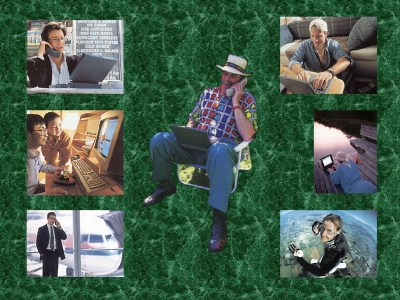 Fig.
1
Fig.
1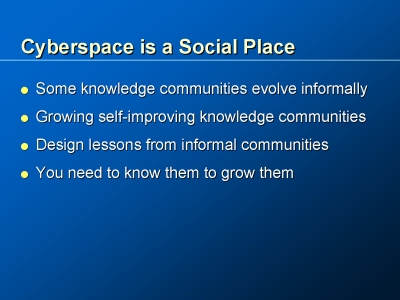 Fig. 2
Fig. 2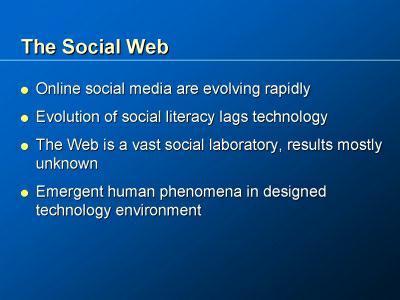 Fig. 3
Fig. 3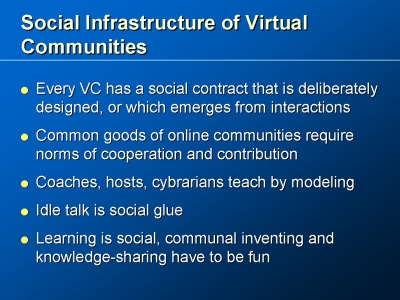 Fig. 4
Fig. 4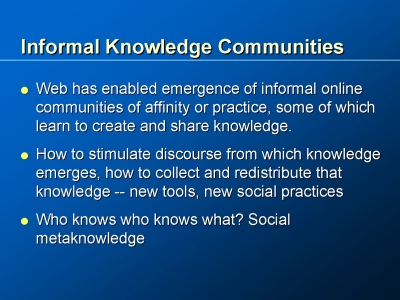 Fig. 5
Fig. 5 Fig. 6
Fig. 6